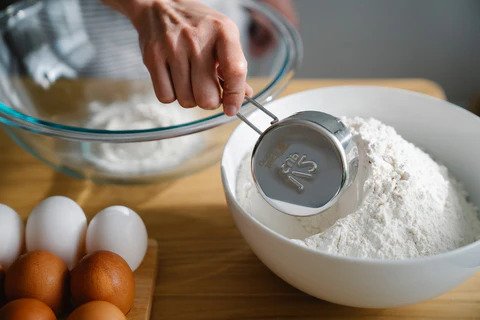The Indisputable Virtue of Precision: Why Accurate Measurement is the Bedrock of Culinary Excellence
In the pursuit of culinary mastery, from the home kitchen to the professional bakeshop, no principle is more fundamental yet more frequently underestimated than the accurate measurement of ingredients. It is a discipline that transcends mere suggestion, forming the scientific and structural backbone of any successful recipe. While cooking may allow for a degree of improvisation, the realms of baking and advanced gastronomy are governed by the precise interplay of chemistry and physics. Inaccuracy is not simply a flaw; it is a variable that guarantees inconsistency, turning the art of cooking into a game of chance rather than a demonstration of skill and knowledge. The consistent production of high-quality food is therefore inextricably linked to the rigorous application of precise measurement.
The Molecular Ballet: Chemical Interactions and Structural Integrity
At its core, a recipe is a chemical formula. Baking, in particular, is a series of controlled reactions where each component has a non-negotiable role. Flour, for instance, provides the structural framework through its proteins, which form an elastic gluten network when hydrated. [1] The protein content itself is a critical variable; high-protein bread flour is essential for the strong, chewy structure of a baguette, while low-protein cake flour yields a tender, delicate crumb. [1] An excess of flour, easily introduced by improper volume measurement, results in a dry, dense product by absorbing too much liquid. [2] Sugar does far more than sweeten; it is hygroscopic, competing with flour for water, which tenderizes the final product by limiting gluten development. [2][3] It is also fuel for the Maillard reaction and caramelization, the browning processes responsible for complex flavors and appealing crust color. [2][3] An imbalance can lead to a collapsed, gummy cake or a pale, flavorless loaf. [2][4] Fats, like butter or oil, physically shorten gluten strands, ensuring tenderness, while leavening agents like yeast or baking powder produce the carbon dioxide gas that gives baked goods their essential lift and texture. [1][5] Even salt, often considered a minor flavoring, is a crucial functional ingredient in breadmaking. It strengthens the gluten network and, through osmosis, regulates the rate of yeast fermentation, preventing the dough from over-proofing, which would result in a weak structure and bland flavor. [6][7] Each ingredient performs in a delicate, codependent balance where a deviation in one can trigger a cascading failure in the final product.
The Incontrovertible Case for Mass over Volume
The most significant source of culinary inconsistency lies in the method of measurement itself: the debate between volume (cups, spoons) and mass (grams, ounces). Professional bakers and pastry chefs universally favor measuring by weight for one simple reason: it is an absolute and reproducible standard. [8][9] A gram is always a gram, regardless of external factors. [10] Volume, conversely, is notoriously unreliable for compressible solids like flour. [11] The actual amount of flour in a “cup” can vary by 25% or more depending on whether the flour is sifted, spooned gently into the cup, or scooped directly from the bag, which compacts it. [12][13] An experiment comparing flour measurement techniques showed that scooping can yield up to 240 grams per cup, while a gentle spooning method yields closer to 140 grams—a massive difference that explains why many home-baked goods fail to replicate their intended results. [11] Furthermore, environmental factors like humidity can alter the density and moisture content of flour, further skewing volume measurements, whereas weight remains constant. [14][15] While a digital kitchen scale may seem like an unnecessary expense to a home cook, it is the single most effective tool for eliminating the primary variable of measurement error, ensuring that a recipe can be replicated with precision time and time again. [16][17] This commitment to a universal standard is what allows for the consistent production that defines professional quality.
Precision Beyond the Bake Shop: Savory Cooking and Modernist Cuisine
The mandate for precision extends well beyond the pastry kitchen into all forms of advanced and even basic savory cooking. While a simple stew might forgive an extra carrot, techniques that rely on specific chemical or physical transformations demand exactitude. In charcuterie, for example, the ratio of salt to meat is not a matter of taste but of safety; incorrect concentrations can fail to inhibit bacterial growth, leading to spoilage. Similarly, modern culinary techniques, often grouped under the umbrella of molecular gastronomy, are entirely dependent on precise measurements to manipulate the texture and form of ingredients. [18][19] Sous-vide cooking, a method where food is cooked in a precisely temperature-controlled water bath, achieves unparalleled consistency in doneness, but the flavor and texture are still reliant on accurately measured brines, marinades, or cures. [20][21] Techniques like spherification, which creates liquid-filled “caviar” from juices or sauces, require exact ratios of sodium alginate and calcium chloride; a slight miscalculation results not in delicate spheres, but a gelatinous puddle. [18][21] These advanced methods highlight a universal truth: control over variables is the key to predictable outcomes. Whether curing a ham, poaching an egg sous-vide, or baking a cake, precise measurement provides the control necessary to transform raw ingredients into a finished product that is not just edible, but exceptional and, most importantly, repeatable.



